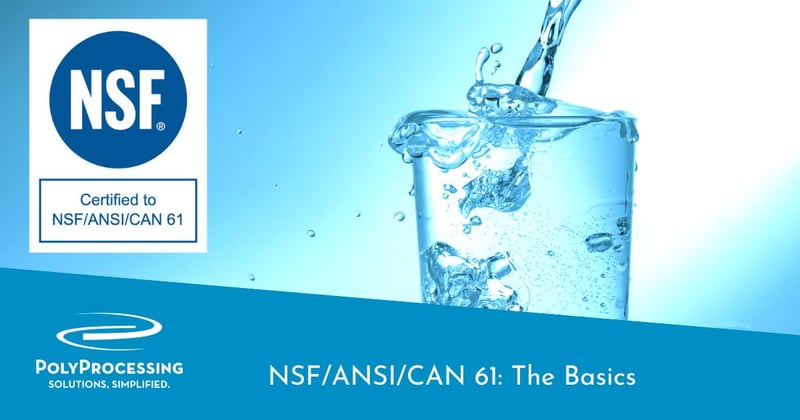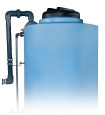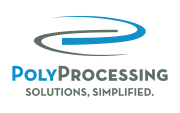NSF/ANSI/CAN 61: The Basics
Most products that come in contact with potable water are tested under NSF 61 with the pH 5, pH 8 and pH 10 exposure waters that are defined in the standard. These exposure waters were designed to simulate the wide variety of potable water chemistries encountered across North America. However, the exposure waters were not designed to predict leaching of materials caused by aggressive chemicals.

To address this concern, NSF created a more extensive standard and certification. As a leader in the chemical storage tank industry, Poly Processing holds this more stringent chemical system certification. To make sure we provide the safest tank systems for drinking water safety, we helped NSF develop the 61 standards and we certified our complete system from tank to bolt washers to this strict standard. Read the NSF Case Study: Poly Processing Looks to NSF for Chemical Storage Tank Certification.
Each component of a public water treatment system is subjected to meeting certain criteria. The most important standard may be the NSF/ANSI/CAN 61 certification. However, there's some confusion as to what it is and what it covers.
Let's look at NSF/ANSI/CAN 61 and discuss how to ensure your chemical storage tanks meet the proper requirements.
NSF/ANSI/CAN 61
NSF/ANSI/CAN 61 is a set of nationally-recognized standards. Developed by the American National Standards Institute (ANSI) and the National Sanitation Foundation (NSF), this standard refers to water treatment requirements. Potable water equipment or products that support its production fall under this standard's jurisdiction.
Everything from ambient temperature water at various pH levels to more dangerous chemicals can be tested. In all cases, the liquid is tested before and after exposure to a given piece of equipment to determine whether anything has been leached out or extracted from the equipment.
How to Tell if Your Chemical System Meets NSF/ANSI/CAN 61
There are various levels of certification that a system can achieve. This is because NSF/ANSI/CAN 61 can apply to so many different concentrations of chemicals. This variance can make understanding a specific certification challenging.
As a result, some manufacturers incorrectly explain certification levels for their products, or you may end up buying the wrong product for your application. In fact, some products listed as NSF-61 certified may only apply to potable water and not to chemical storage or vice versa.
Many manufacturers are only testing pH 5, pH 8, and pH 10 exposure waters at ambient temperature, which is for potable water storage only. What they fail to account for is potential leaching of materials in chemical storage tanks.
We recommend visiting the NSF website to ensure a product meets the standards based on the chemical application and that the certification is for the specific chemical and not for potable water storage. Verify the components listed by the manufacturer, along with the name of the chemical and its percentage concentration. A less-than (<) symbol means that a tank is certified to store up to that level of concentration.
A full system certification includes even small parts. Smaller parts like gaskets and fittings must also pass certification to consider the full system certified. It's important that all materials meet this standard for potable water and chemical storage.
Poly Processing Offers a Smart Solution
Among chemical tank manufacturers, Poly Processing is the only one with a complete chemical storage tank system that is NSF/ANSI/CAN 61 certified. Currently, we have NSF 61 Certification for 38 of the most popular water treatment chemicals on our XLPE tank systems.
Our certifications also cover XLPE tanks with our innovative OR-1000™ System. This system is designed and engineered to extend the useful life of a tank storing oxidizing chemicals, such as sodium hypochlorite or sulfuric acid.
In the next NSF/ANSI/CAN 61 article, we’ll look at the differences between NSF 61 chemical certification and NSF 61 potable water certification. We’ll also discuss the testing that takes place and how you can be sure your tank system is completely certified to the right standard for its intended use.
To find out more about NSF-61, download your copy of our NSF/ANSI/CAN 61 Certification eBook.
- March 27, 2023
- Topics: Certifications and Standards
About Poly Processing
Posts By Topic
Tech Talk Podcast Episodes
Subscribe By Email
Recent Posts
- Installation Tips for Chemical Storage Tanks: Site Preparation and Offloading
- Understanding pH and Chemical Concentration When Choosing a Chemical Tank
- Maximizing Fill Efficiency: Selecting the Optimal Fill Line System
- Chemical Storage Tanks: A Quick Guide for End Users
- Popular Customization Options for Chemical Storage Tanks
Tank Configurator

Find the recommended tank and system components for your chemical storage challenge.
Configure a Tank Package





